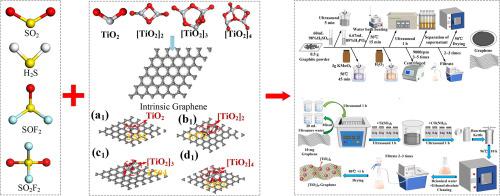Applied Surface Science ( IF 6.3 ) Pub Date : 2023-05-30 , DOI: 10.1016/j.apsusc.2023.157630 Hong Liu , Weigen Chen , Zhixian Zhang , Haoyuan Tian , Tian-Yi Sang , Kejie Wu , Zijie Tang

|
SF6 gas will decompose four characteristic decomposition products (H2S, SO2, SO2F2 and SOF2) when an insulation failure occurs early in SF6 gas-insulated equipment. By building gas-sensitive sensors into insulation devices it is possible to detect the characteristic gases of insulation faults. In this paper, we use Graphene which is available with good gas sensitivity, as a substrate and then improve the gas response of Graphene by doping with TiO2 clusters. The adsorption mechanism of (TiO2)n-Graphene (n = 1–4) on four characteristic decomposition gases is firstly analyzed based on first principles, and then verifies experimentally. (TiO2)n-Graphene (n = 1–4) shows the largest change in Eg after adsorption of SO2 gas with 61.70%, 1.07%, 23.19% and 64.04%, respectively. The SEM characterization shows that Graphene has an obvious lamellar structure, and TiO2 nanoparticles are mainly distributed on the outer wall of Graphene, which has a large curvature and strong surface activity. The gas-sensitive response values of the (TiO2)n-Graphene (n = 1–4) sensor for different gases at the same gas concentration are ranked as SO2 > H2S > SO2F2 > SOF2. The results show that TiO2 cluster-doped Graphene is a potential gas-sensitive sensing material that can be a new material for online monitoring of faulty gas content in SF6 gas-insulated equipment.
中文翻译:

研究不同TiO2浓度掺杂石墨烯对SF6分解产物的气敏响应
SF 6气体绝缘设备早期发生绝缘故障时,SF 6气体会分解四种特征分解产物(H 2 S、SO 2、SO 2 F 2和SOF 2 )。通过将气敏传感器内置于绝缘装置中,可以检测绝缘故障的特征气体。在本文中,我们使用具有良好气敏性的石墨烯作为基底,然后通过掺杂TiO 2团簇来提高石墨烯的气敏性。(TiO 2 ) n -石墨烯( n = 1-4) 对四种特征分解气体首先基于第一性原理进行分析,然后进行实验验证。(TiO 2 ) n -石墨烯( n = 1–4)吸附SO 2气体后E g 的变化最大,分别为61.70%、1.07%、23.19%和64.04%。SEM表征表明,石墨烯具有明显的层状结构,TiO 2纳米粒子主要分布在石墨烯的外壁,曲率大,表面活性强。(TiO 2 ) n -石墨烯( n = 1–4) 相同气体浓度下不同气体的传感器排序为SO 2 > H 2 S > SO 2 F 2 > SOF 2。结果表明,TiO 2簇掺杂石墨烯是一种潜在的气敏传感材料,可作为SF 6气体绝缘设备故障气体含量在线监测的新型材料。











































 京公网安备 11010802027423号
京公网安备 11010802027423号